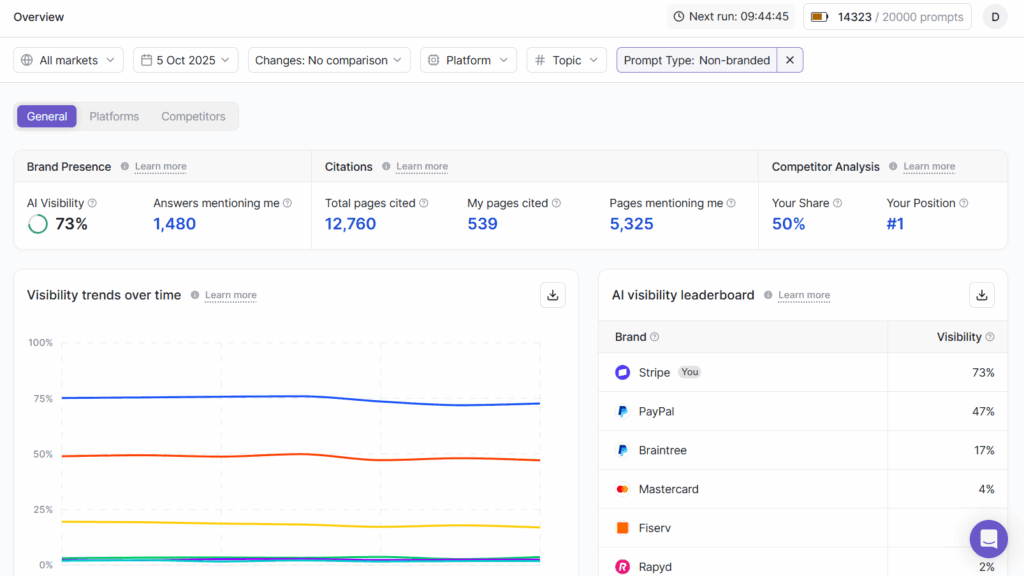Why Modern SEO Needs Both


“Ranking on Google is enough, you don’t need to get cited by AI.”
That’s one true statement if you want to keep ignoring ChatGPT’s 800 million+ user base, Gen Z’s tendency to make AI their shopping assistant, and the fact that 79% of users now trust AI as much as they do Google.
Google is still dominant, yes. But ignoring AI search isn’t an option. For a well-balanced marketing strategy, you need to do well in both ways: rank high and get cited.
In this article, we’ll see the nuances of ranking high vs getting cited: how the strategies behind them, and the results they provide are different, and important.
Key Takeaways
- Rankings bring predictable traffic and measurable conversions by driving users directly to your site
- Citations build long-term authority and brand trust by placing your content inside AI-generated answers
- Rankings and citations work best together, delivering both immediate results and lasting visibility
- Writesonic gives you the tools to track citations, measure AI visibility, and optimize for both SERPs and AI answers in one place
What does Getting Cited by AI Mean?
When I say getting cited by AI, it means your website or content shows up as a reference inside generative AI answers, whether that’s ChatGPT, Google AI Overviews, Bing Copilot, or any other assistant.
It’s the equivalent of being a “blue link” in traditional search, except instead of sitting on a results page, your brand directly appears as an authoritative source that AI got its answer from.
For example:
- When ChatGPT answers a query about “project management,” it may cite ClickUp, Asana, or Notion’s blogs with links.
- When Google AI Overviews explains “how to optimize internal links,” it may pull and cite content from authoritative SEO blogs.
These citations give you tangible outcomes like:
- Visibility inside answers: Your brand shows up directly within the response users read.
- Credibility signal: A citation indicates that the AI trusts your content enough to reference it.
- Traffic potential: While clicks may be fewer than in SERPs, citations still drive qualified visits.
- Brand recall: Even without a click, being mentioned in an authoritative answer builds awareness.
What Does Ranking High Mean?
Ranking high means your website appears at or near the top of Google’s search results for a given query. Search engines decide these positions based on hundreds of signals: from keyword relevance and backlinks to technical SEO and site performance.
Unlike citations, which place your brand directly inside an AI-generated answer, rankings show your page as one of many clickable options on a results page. Your visibility depends on placement: the higher you rank, the more likely users are to notice your link and click through.
For example:
- A site ranking #1 for “best project management tools” will usually capture the largest share of clicks, even if users also scan other results.
- A blog ranking on page two may get little to no traffic, even if the content is excellent, simply because users rarely scroll that far.
In short, ranking high is still the most reliable way to drive steady, measurable traffic to your site — but it also means you’re competing in a crowded field of ads, snippets, and other organic results.
Ranking High vs Getting Cited by AI: The Differences
Ranking in SERPs has been the ultimate SEO goal, with many content marketers even claiming that as enough to get cited in AI. But that’s not true. Even if both ranking high and getting cited drive visibility, the way they are chosen, the function, and the impact are all different.
Ranking on Google
- Decided by search engine algorithms.
- Influenced by keywords, backlinks, technical SEO, and site performance.
- Designed to list pages from most to least relevant for a query.
Getting Cited by AI
- Decided by generative models while they build an answer.
- Influenced by how clear, authoritative, and machine-readable your content is.
- Displayed as references directly inside the AI’s response.
Where users “choose” a link to click when you rank high, AI already marks you as a credible source for relevant content when you get cited.
And here’s where it gets interesting:
- A page stuck on page two of Google can still get cited in an AI answer and win visibility.
- A page dominating the SERPs may never get mentioned in AI results if it’s not optimized for GEO.
This is why ranking and citations should be treated as separate but complementary goals in a modern search strategy.
Apart from what they mean, ranking high and getting cited also have several other key differences:
1. Visibility Channel
- Ranking High: When your site ranks high in the SERPs, it appears in a list of options that users can browse.
Your visibility is tied to placement: the higher you rank, the more likely you are to get clicks. But you’re still competing with ads, featured snippets, and other search features, including AI overviews which cite content.
- Getting Cited: A citation places your brand with the AI-generated answer itself. Instead of being one of many options on a results page, your content is presented as part of the authoritative explanation.
This means your visibility isn’t dependent on position in a long list, but on being chosen as a trusted source.
Why it matters:
- SERPs make users choose from multiple results.
- Citations give you instant visibility in the exact answer the user consumes.
2. User Journey Impact
- Ranking High: A top position means higher click-through rates. Once users land on your site, you control the experience, from reading content to converting into leads or customers. Ranking is a direct driver of site visits and measurable outcomes.
- Getting Cited: Citations don’t always lead to clicks. Many users will consume the AI-generated answer and move on.
However, being cited reinforces your brand as a credible authority. Even if they don’t visit your site immediately, users start to associate your brand with expertise. Over time, this builds recognition and trust that can influence future decisions.
Takeaway:
- Rankings shape immediate user actions by sending traffic.
- Citations shape long-term perception by embedding your brand in authoritative answers.
3. Optimization
- Ranking High: SEO for rankings leans heavily on traditional practices. You need to research keywords, optimize on-page elements (titles, headers, meta descriptions), improve site speed, and earn backlinks. It’s about proving to search engine algorithms that your page is the most relevant and authoritative for a given query.
- Getting Cited: Citations require content that’s easy for AI systems to parse and reuse. This means writing with clarity, using structured formats like FAQs or schema markup, and covering topics comprehensively. AI models favor content that directly answers questions, avoids fluff, and provides factual depth they can pull into answers.
Key difference:
- Traditional SEO for ranking caters more to search engine algorithms.
- Optimizing for citations is more catering to how AI systems read and generate content.
Read more about how traditional SEO is different from GEO.
4. Measurement & Tracking
- Ranking High: Tracking is straightforward with a simple Google search or with established tools like Google Search Console. You can monitor keyword positions, impressions, click-through rates, and traffic. Rankings provide clear numbers to measure progress and ROI.
- Getting Cited: Measuring citations is newer and less standardized. Citations appear different each time users search a prompt. So you need proper AI visibility platforms like Writesonic that show when and where your pages are mentioned in AI answers across AI systems.
Key difference:
- Tracking rankings is more established.
- Citations are newer and more dynamic and require dedicated tracking tools.
5. Longevity & Stability
- Ranking High: Rankings change less frequently compared to AI citations. Your page may stay in the same average position unless a competitor writes a better blog, your page becomes outdated, or Google releases a major SERP update.
- Getting Cited: Citations don’t appear the same for everyone. The same prompt, used in two different AI models or in two different regions, gives vastly different citations. You need to get cited in all relevant prompt variations to build consistent visibility.
Key difference:
- Rankings are relatively stable, shifting gradually with algorithm updates or competitor changes.
- Citations are volatile, changing with prompts, model updates, and even user context.
6. Impact & Conversions
- Ranking High: Rankings drive direct, measurable traffic. A higher position in the SERPs means more clicks, more visitors on your site, and more chances to convert those visitors into leads or customers. The impact shows up quickly in metrics like sessions, conversions, and revenue.
- Getting Cited: Citations work differently. Many users won’t click through from the AI-generated answer, but the credibility you earn compounds over time.
And while the clicks may be fewer, they’re often more qualified. People clicking a cited link have already read the AI’s summary, so they arrive more educated and context-aware. That makes them stronger prospects, even if the traffic volume is lower.
Key difference:
- Rankings deliver immediate traffic and short-term conversions.
- Citations strengthen long-term brand equity and purchase intent, while sending you highly qualified, context-ready visitors.
Ranking High vs Getting Cited: How to Win in Both?
Ranking and citations are complementary goals for a successful marketing strategy. Rankings bring you traffic. Citations make sure your brand shows up in the answers people rely on. To stay competitive, you need both.
This is exactly what Writesonic intends to simplify. It provides you with the tools to do well in both traditional SERPs and AI answers.

With Writesonic, you can:
- Track AI Citations: See exactly when and where your pages are being cited in ChatGPT, Google AI Overviews, Bing Copilot, and beyond.
- Measure AI Visibility: Understand how often your brand appears in generative answers compared to competitors.
- Optimize for GEO (Generative Engine Optimization): Get actionable insights into how to structure, clarify, and enrich your content so AI systems are more likely to cite it.
- Balance Rankings + Citations: Use Writesonic’s all-in-one SEO + GEO tools to keep climbing Google SERPs while also building your authority inside AI-generated answers.
In short, Writesonic helps you go beyond rankings and claim your share of AI visibility, so your brand is trusted, cited, and clicked wherever people search.
See it in action.
FAQs for Ranking High vs Getting Cited
1. Can ranking high in Google automatically get me cited by AI?
Not necessarily. While strong rankings signal authority, AI models don’t always pull from the top SERP results. They look for content that’s clear, factual, and structured in ways that are easy to parse.
2. How do I optimize content to get cited by AI?
Focus on clarity, structured formats (like FAQs, step-by-step guides, and schema), and comprehensive, fact-backed coverage of topics. This makes your content more usable for AI-generated answers.
3. How can I measure whether my brand is being cited in AI answers?
Traditional SEO tools won’t show AI citations. You need AI visibility platforms like Writesonic to track when and where your pages are cited in ChatGPT, Google AI Overviews, Bing Copilot, and other AI systems.










